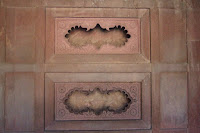 Travel Date 15th March 2008
Travel Date 15th March 2008Click on any picture to see a larger version.


This was the first of the fort palaces of India that I saw; and what a palace to start with. From it’s origins in the 11th century until it’s peak in the reign of Shah Jehan in the 17th century the Red Fort in Agra was a major power centre in India, and for much of the later period was the main Palace of the Mughal Ruler of the time, making Agra the capital in those periods. Shah Jehan transferred the capital to Delhi, but added many buildings to the Agra fort complex and was the ruler who built the Taj Mahal nearby.



I’ll let the pictures tell the story of the fort; some of the history is detailed on the text pictures. The first thing to impress me was the quality of the architecture and the workmanship in nearly every building. During centuries when European civilisation was groping it’s way towards the light at the end of the dark ages, the artisans, masons and craftsmen of India were building masterpieces. The influences of many cultures appear in India but the predominant influence here was Mughal, conquerors of Mongol stock who had absorbed the culture and the Muslim religion of Persia before coming to rule over India.




Before I saw the Red Fort I had seen the Topkapi of Istanbul and the Alhambra of Granada. The similarities in construction and styles were striking, all have roots in Asia Minor and Arabia.
The most fascinating part of that history, to me, is the story of Shah Jehan. He came to power in 1628 at a time when his Empire was crumbling. Over the years of his reign he used his military prowess to put down rebellions and consolidate and expand the Empire and commenced a vast expansion of building projects, especially in Delhi and Agra.




His lavish spending included the wonderful Peacock Throne, made of gold covered with rare jewels; a century later that same throne was captured by the Persians and became the fabulous throne of the Shah of Iran until his demise in 1979.




But even Emperors can break the bank, and his wars, lavish building projects and other extravagances finally did and he became unpopular with his people as the taxes rose. Then, when he became ill after reigning for nearly thirty years his four sons fought and intrigued until only one successor was left, Aurangzeb, who promptly imprisoned his father here in the Red Fort at Agra and ruled in his place.


The great Emperor Shah Jehan died eight years later, within sight of his beloved wife's tomb in the Taj Mahal. The story goes that Shah Jehan had intended to build a matching mausoleum to the Taj Mahal on the opposite bank of the river in black marble; there is no evidence to support that, but it’s a nice story.



Cheers, Alan

No comments:
Post a Comment